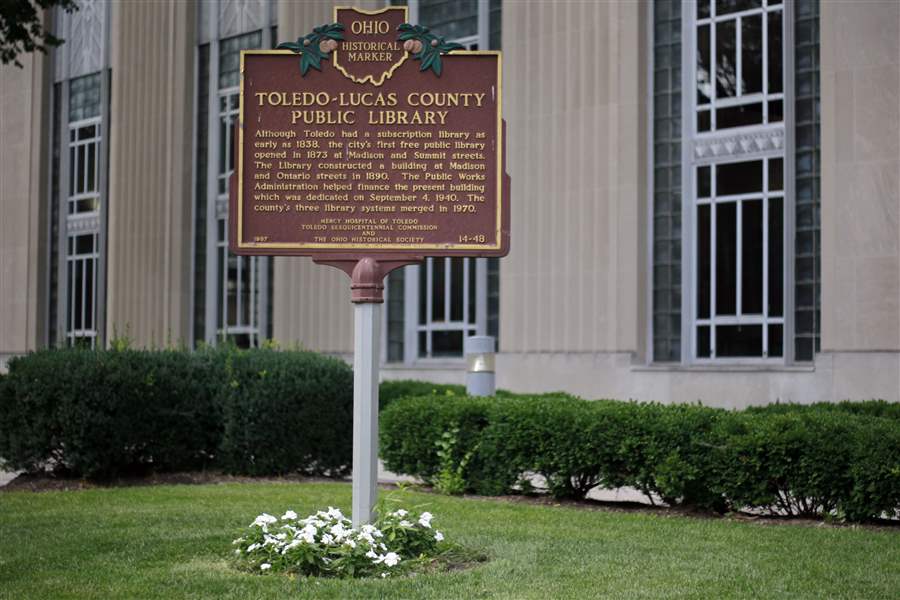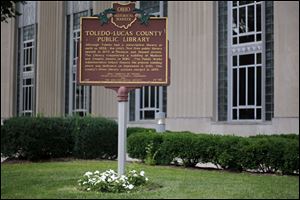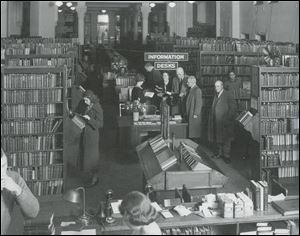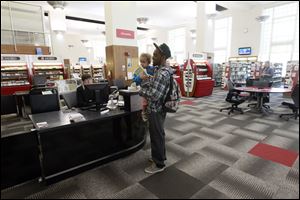
Library marks 175th year of serving the community
9/1/2013
Downtown’s Main Library at 325 Michigan St. opened on Sept. 5, 1940. The library system’s history dates to 1838, making it the first free public library in Ohio. Today, the ‘People’s University’ is home to the fifth-largest collection in the state.
THE BLADE/AMY E. VOIGT
Buy This Image

Downtown’s Main Library at 325 Michigan St. opened on Sept. 5, 1940. The library system’s history dates to 1838, making it the first free public library in Ohio. Today, the ‘People’s University’ is home to the fifth-largest collection in the state.
When Toledo’s population numbered in the hundreds rather than the hundreds of thousands, the pages of history started to turn toward what would become the Toledo-Lucas County Public Library.
This year, the library system bookmarks its 175th anniversary by featuring several special events, some already celebrated — such as cookies and milk for youngsters plus a puppet show and a video — and others yet on the calendar, including a rooftop cocktail-casual party and a black-tie-optional gala, complete with a five-star dinner and a well-known keynote speaker.
As it celebrates such a significant milestone, the Toledo-Lucas County Public Library continues to reflect the meaning of the inscription on the Main Library building: “Books are the legacies that a great genius leaves to mankind, that are delivered down from generation to generation as presents to the posterity of those yet unborn.”
Click here for more stories on the Toledo-Lucas County Public Library.
Children are among those who amble in, awed by the Main Library’s sophisticated, sprawling space dedicated to words in books or in the cloud. “They look around and ask, ‘Is this a mall? Is this a hotel?’” remarked Nancy Eames, the library’s coordinator of youth services. Many kids today have been to malls and perhaps hotels, but many have never stepped inside the Main Library until a summer camp field trip or a special program brings them here.
Actually, adds Meg Delaney, Main Library manager, the mall comparison is apt.
“The 1940 building was designed to be a department store of sorts for information, for history, for social science, for the arts,” she said.
The Main Library, with a mission to provide information, education, and technology to help the community live, learn, and grow, is at 325 Michigan St. in downtown Toledo.
Situated at a pivot point in the city, on the fringe of the downtown and the southern anchor for Uptown, staff members are eager to have the Main Library involved in both areas and beyond. “We want to be a beacon,” Ms. Delaney said.
Its history dates to 1838, making it the first free public library in Ohio. Today, the library, known as “The People’s University,” is home to the fifth-largest collection in Ohio.
Branching out
Dedicated to customers through the decades, the library system has branched out more than its founders could have imagined 175 years ago.
Beyond bricks and mortar, beyond the ink-and-paper best-sellers — technology, technology, technology. Local libraries have been on the cutting edge of tech advances for many years. In 1956, for instance, 76 films, 22 in color and 54 in black and white, were added to the collection, and showings of filmstrips took off with the availability of the loan of a filmstrip projector.
But it was 1911 when the Format Wars were launched. That year 184 music rolls for player pianos were added to the available-for-loan items. Today? Music pops, raps, hip-hops. Blues, jazz, country, gospel, and more are available on loan in various formats from the library.
Throughout the years, reading trends, and the library’s bottom line, at times reflected news headlines. Recessions, including the Panic of 1873, caused financial problems for the library.
In 1943 the library clearly demonstrated its character as an educational institution essential to the war effort. It established War Information Centers, making available to civilians the latest data on the war and its application to civilian wartime problems. “People are thinking seriously of living adjustments in wartime rather than on the more technical problems, and consistently select books on gardening, health, poultry raising, canning, foods, diet, etc., in preference to training for manual arts,” a 1943 library report stated.

The Main Library has stood as a downtown landmark since 1940. In 1970, three library systems merged to form the current countywide Toledo-Lucas County Public Library.
Through the years
If you want interesting, the library sparkles with “Did you know ...?” nuggets.
In 1956, more borrowers were lax in returning their books with first overdue notices, increasing nearly 34 percent from the previous year. And Fido? He was in the doghouse. “Dogs were responsible for most of the damage done to our books,” the library report stated.
Dogs have hounded library materials for years ... we’re not talking turned-down, dog-eared corners but rather chewed-through books. Possibly the glue used in bookbinding entices pooches to sniff out and gnaw on items borrowed by readers.
And bookworms? The county is crawling with them.
Click here for library timeline.
Consider this: The first “Vacation Reading Club” was introduced in 1924 with a Travel Club theme. Some 85 children participated. Then, numbers zoomed. In the past 30 years, 366,283 people have participated, reading a total of 3,039,105 books.
Since 2001, participants count minutes instead of books, allowing older children to read longer books and not be penalized for reading fewer books than young children. Since the change, children have read 1,423,173 hours — the equivalent of 162 years of reading.
For several years, youngsters were limited to the Main Library’s second-floor Boys’ and Girls’ Room. Children had a separate entrance and a separate restroom. A door leading beyond that room was stenciled with a message basically telling youngsters “Keep Out.” Then, in the 1950s, children were granted full access to the Main Library. Originally, the Boys’ and Girls’ Room was destined for the basement of the new Main Library, but Ethel Wright, head of the children’s department at that time, didn’t want to go by the book. She persuaded the architect to locate the children’s room on the second floor, a move still applauded today.

Changing landscape
Other changes? In so many words, sure, oodles of them.
In the library’s earliest years, few books were available, but that likely worked out fine, considering only 66 residents signed up in 1838 when a charter was granted to the Toledo Young Men’s Association by the Ohio legislature to establish a lyceum and public library. Toledo’s population then was about 1,000. In 1846, reading rooms in the Gordon Block at 170 Summit St., between Madison Avenue and Adams Street, provided a lecture series and access to magazines, newspapers, and books. By 1864, the library collection had blossomed to 4,000 volumes.
Today, the Toledo-Lucas County Public Library offers adult book discussion groups; enrichment for adults on a variety of topics; story times for children; programs for elementary school-aged children and teens; computers for reference database searching, word processing, and Internet access; meeting rooms for community use, and teacher collections.
By the numbers
The library system’s count of materials, including material bar codes and digital downloads, equaled 2,418,153 for 2012.
Last year, the library circulation/items borrowed totaled 6,931,417, and the library system had 325,011 card holders, including about 70 percent of Lucas County residents. Ohio residents are eligible for a free Toledo-Lucas County Public Library card; the library has a number of cardholders who live in Michigan and some from every state and from other countries.

Library employee Regina Stevenson-Healy, left, helps Terrance Smith and his daughter Lilliana Smith, 2, check out cartoon DVDs in the audio-visual area.
Quest for data
On a recent day at the Main Library, Ellie Richey of Toledo bent over a bunch of thick books on the history of Seneca County, Ohio, hoping to trace another thread to tie together her ancestors. “I have a big, scattered family. They have good resources here and I get particularly interested when I find old records about family members.”
During weekends, information-seekers jam pack the local history and genealogy area, Ms. Delaney said. History comes to life from death certificates and other documents available at the library.
At the Main Library, a wow-look-at-that Tablet to Tablet exhibit shows off changes in communication in the last couple thousand years or so. A Babylonian Cuneiform, dated 2350 BCE, carves out the start of the written word timeline that includes circuit boards and spaghetti strands of cords, circa the early 21st century.
Ms. Delaney pointed out how the vessel, the device for reading, continues to evolve, but “content is content. Whether you listen to a book on tape, whether you read a book on a tablet or on paper, it’s the reading that counts. Think back 175 years. The library had a much smaller space, but we were connecting people with content. We were identifying tools to make lives better. With changes, we use whatever tools there are today to continue to make lives better.”
Preservation
Ms. Eames noted the library’s ongoing efforts to collect, save, and protect rare materials and local history documents related to who we are, where we’ve been, where we’re headed. “Nobody else does that. The library does the best job of saving our stuff.”
“History continues each day,” added Ms. Delaney. “The library always has been the best resource for our past.”
In present day, right here, right now, the 175th anniversary of the Toledo-Lucas County Public Library leaps off the page, adding another chapter to this wrapped-in-words gift to the community.
As stated by Andrew Carnegie and inscribed on the Main Library: “A library outranks any other one thing that a community can do to benefit its people.”
Contact Janet Romaker at: jromaker@theblade.com or 419-724-6006.